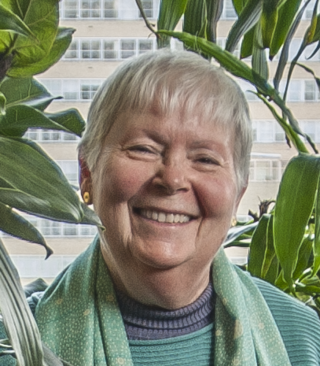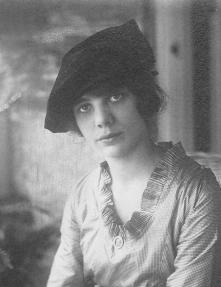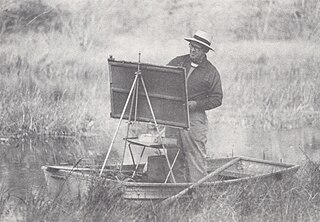Richard Joseph Anuszkiewicz was an American painter, printmaker, and sculptor.

Mary Elizabeth Price, also known as M. Elizabeth Price, was an American Impressionist painter. She was an early member of the Philadelphia Ten, organizing several of the group's exhibitions. She steadily exhibited her works with the Pennsylvania Academy of the Fine Arts, the National Academy of Design, and other organizations over the course of her career. She was one of the several family members who entered the field of art as artists, dealers, or framemakers.
Louise Fishman was an American abstract painter from Philadelphia, Pennsylvania. For many years she lived and worked in New York City, where she died.

Diane Burko is an American painter and photographer. She is currently based in Philadelphia and Bucks County, Pennsylvania. Her work addresses landscape, climate change and environmental activism.

Howardena Pindell is an American artist, curator and educator. She is known as a painter and mixed media artist, her work explores texture, color, structures, and the process of making art; it is often political, addressing the intersecting issues of racism, feminism, violence, slavery, and exploitation. She is known for the wide variety of techniques and materials used in her artwork; she has created abstract paintings, collages, "video drawings," and "process art."

John Moore is an American contemporary realist painter. His art has focused on studio interiors, still lifes, and in his best-known work, cityscapes and the American post-industrial landscape of dilapidated mill towns and factories. He emerged in the early 1970s amid a resurgence of representational work, appearing in many surveys and critical examinations that helped define new modes of American realism. While the highly detailed nature of his work evokes that movement, it diverges from approaches such as photorealism in its social concern, painterly handling and composite compositions, which distill direct observation, sketches, memories and photographs of multiple sites and views into re-imagined but believable scenes. Curator John Stomberg wrote of these constructed worlds: "The image he creates is only real in the painting, yet all the parts do have their origins in the observable world. Therein lies the eerie potency of Moore's vision—its plausibility. He is more of a spectacular fabulist than a realist."

Florence Esté was an American painter in oils born in Cincinnati, Ohio. She also worked in watercolors, pastels, and as an etcher and engraver. She was particularly well known for her landscapes, which were said to have been influenced by Japanese artworks and were noted for their "harmony of color". Her obituary in the New York Times referred to her as "one of the best known women landscape painters."

Linda Lee Alter is an American visual artist who is primarily known as an art collector and philanthropist. In 2010 Alter donated five hundred artworks by American female artists to the Pennsylvania Academy of the Fine Arts in Philadelphia, Pennsylvania.
Sarah McEneaney is an American artist, painter, and community activist who lives and works in Philadelphia, Pennsylvania. Working primarily in egg tempera her paintings are characterized by their autobiographical content, detailed brushwork, and brilliant color. McEneaney's intimate subject matter focuses on daily scenes from her home, studio, travels, and neighborhood. Her work is included in public collections such as the Philadelphia Museum of Art and she has received numerous grants and awards. McEneaney is also active in community work, including the formation of the Callowhill Neighborhood Association in 2001, and the co-founding of the Reading Viaduct Project in 2003.
Jane Irish is an American artist, painter, and ceramicist who lives and works in Philadelphia. Working primarily in gouache and egg tempera her paintings are characterized by their perspectives of Rococo interiors and explorations of the legacy of the Vietnam War. Irish infuses sumptuous interiors with memories of colonialism and orientalism, sometimes making raised text within her painting surfaces, which feature war poetry or historical protest text. The text on the surface of her ceramics includes collaborations with prominent art critics like Vincent Katz and Carter Ratcliff and poetry from Vietnam war veterans from a 1972 collection.
Elizabeth Osborne is an American painter who lives and works in Philadelphia. Working primarily in oil paint and watercolor, her paintings are known to bridge ideas about formalist concerns, particularly luminosity with her explorations of nature, atmosphere and vistas. Beginning with figurative paintings in the 1960s and '70s, she moved on to bold, color drenched, landscapes and eventually abstractions that explore color spectrums. Her experimental assemblage paintings that incorporated objects began an inquiry into psychological content that she continued in a series of self-portraits and a long-running series of solitary female nudes and portraits. Osborne's later abstract paintings present a culmination of ideas—distilling her study of luminosity, the landscape, and light.

Sarah Jane Blakeslee was an American landscape and portrait painter.
Katie Baldwin is an American printmaker and book artist living in Huntsville, Alabama. She is currently an Assistant Professor at the University of Alabama in Huntsville. She received her Bachelor of Fine Arts from Evergreen State College in Olympia, Washington and her Master of Fine Arts from the University of the Arts (Philadelphia). She served as a Victor Hammer Fellow at Wells College from 2011-2013. Baldwin produced the book Treasure at Women's Studio Workshop.

Jane Gibson Piper (1916–1991) was an American artist known for her abstract treatment of still lifes. Building on the French modernist tradition of Matisse and Cézanne, she gave color precedence over representation. Shortly after her death a critic said "throughout her career Piper worked within a relatively narrow aesthetic range. She was interested in spatial organization and in creating space through color — concerns of another painter she admired, Henri Matisse. There's a sense of Matisse in her later work, but no indication that she was trying to imitate him; the resonance reflects shared concerns." From her first exhibition in 1943 through the end of her life she was given a total of thirty-four solo exhibitions in Philadelphia, New York, and other East Coast galleries and her works have been collected by major museums including the Philadelphia Museum of Art, the Pennsylvania Academy of the Fine Arts, the Brooklyn Museum, the National Academy of Design, The Phillips Collection, and the Carnegie Museum of Art.

Grace Thorp Gemberling was an American artist known for the broad range of her subjects in paintings having a pronounced psychological as well as aesthetic impact. One critic said they conveyed a mood that was "ethereal, bold and engaged." Another said her work showed "a disciplined hand and a romantic eye" together with "a magical color sense." Known for her control of detail and successful handling of line and blocks of color, she was said to paint in a modernist style that stayed clear of abstraction and was remembered by a teacher and fellow artist as "the finest woman painter in Philadelphia during the 20s and 30s."
Bill Scott is a contemporary abstract painter and printmaker who works and lives in Philadelphia. Scott studied painting at the Pennsylvania Academy of the Fine Arts from rom 1974 to 1979, and with the painter Jane Piper (1916–1991).
Sally Michel Avery was an artist and illustrator who created modernist paintings of abstracted figures, landscapes, and genre scenes capturing personal moments of every day life. She was the co-creator of the "Avery style", wife and collaborator of artist Milton Avery, and mother of artist March Avery. Throughout their lives, Michel and Avery shared their studio space together, painting side by side, critiquing each other's work, and developing a shared style which includes the use of abstracted subjects, expressionistic color fields, and harmonious but unusual colors juxtapositions. Michel's work is the collections of the Metropolitan Museum of Art, the National Gallery of Art, the Pennsylvania Academy of Fine Arts, the Wadsworth Atheneum, and the Israel Museum, among others.

Roswell Weidner was an American artist known for his paintings, charcoal and pastel drawings, and prints. His subject matter included still life, landscapes, and portraits. He was a student at the Pennsylvania Academy of the Fine Arts (PAFA) city school and country school in Chester Springs, and the Barnes Foundation. He worked in the Works Progress Administration Arts Project during the Great Depression and in a shipyard as an expediter during World War II. Weidner began teaching at the Pennsylvania Academy of the Fine Arts in 1938. He was associated with the academy for 66 years, first as a student and later as a teacher, until his retirement in 1996.
Virgil Marti is an American visual artist recognized for his installations blending fine art, design, and decor from a range of styles and periods. Marti’s immersive sculptural environments, often evoking nature and the landscape, combine references from high culture with decorative, flamboyant, or psychedelic imagery, materials, and objects of personal significance.

Samuel Joseph Brown Jr. (1907–1994) was a watercolorist, printmaker, and educator. He was the first African American artist hired to produce work for the Public Works of Art Project, a precursor to the Work Progress Administration's Federal Art Project. Brown often depicted the lives of African Americans in his paintings. He worked primarily in watercolor and oils, and he produced portraits, landscapes and prints.












